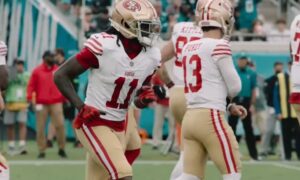By Matthew Marczi
Much has been made of the fact that Pittsburgh Steelers outside linebacker LaMarr Woodley has only generated four sacks over the past season and a half since he blew out a hamstring running down Tom Brady midway through the team’s Week 8 victory over the New England Patriots in 2011.
With that in mind, I thought it would be interesting to take a look at his career as a starter in terms of generating pressure on the quarterback and how his game has been impacted post-injury. Of course, more injuries in 2012 exacerbate the circumstances, but nevertheless, midway through the 2011 season is a satisfying dividing line, considering he was entering his name into the Defensive Player of the Year race at that point.
It is worth noting that, using data from Pro Football Focus, half-sacks are credited as a full sack; additionally, certain sacks that other sources track and count, PFF does not (for example, Jason Worilds’ ‘sack’ of Brandon Weeden last season is not counted in their data). Thus, some anomalies in the data show up, such as Woodley’s being credited with 10 sacks in 2011 (he had two half-sacks), yet nine in 2010 (where the NFL counted 10).
Still, to be consistent with the data, and since they also track quarterback hits and hurries with regularity, PFF’s sack totals will be used.
The chart below expands upon the earlier article examining how often Woodley (and James Harrison) actually rushed the quarterback on passing downs by contextualizing them with performance numbers as a pass rusher.
One of the site’s key metrics for pass rushers is called Pass Rushing Productivity. Like Pass Blocking Efficiency, the PRP number takes into account the fact that sacks are more valuable than hits and hurries, and thus weighs the latter on a lesser scale (as the case may be, three-fourths of a sack). Thus, PRP should give a more accurate portrayal of a pass rusher’s performance than simply his rate of success in generating pressure.
| Year | Pass | Pass Rush | Rush % | Sacks | Hits | Hurries | Total | Success Rate | PRP |
|---|---|---|---|---|---|---|---|---|---|
| 2008 | 543 | 349 | 64.3 | 10 | 8 | 18 | 36 | 10.3 | 8.5 |
| 2009 | 602 | 366 | 60.8 | 13 | 15 | 31 | 59 | 16.1 | 13 |
| 2010 | 592 | 401 | 67.7 | 9 | 7 | 50 | 66 | 16.5 | 12.9 |
| 2011* | 283 | 194 | 68.6 | 10 | 2 | 11 | 23 | 11.9 | 10.2 |
| *2011 | 38 | 26 | 68.4 | 0 | 1 | 0 | 1 | 3.8 | 2.9 |
| 2012 | 362 | 235 | 64.9 | 4 | 8 | 14 | 26 | 11.1 | 8.7 |
As can be seen in the data above. Taking a look at the 2009 and 2010 seasons, Woodley actually had a higher success rate in 2010 by generating pressure on 16.5 percent of his pass rushes, as opposed to 16.1 percent in 2009. However, Woodley was able to convert a greater number of his opportunities into sacks, so his Pass Rushing Productivity in 2009 was ever so slightly higher in 2009 (13.0) than in 2010 (12.9).
As a matter of fact, Woodley’s 13.0 PRP in 2009 was good enough to top all outside linebackers that season. In 2010, he actually finished second to the Kansas City Chiefs’ Tamba Hali, whose 17 sacks helped him earn a PRP score of 14.8. As it turns out, that score is the second-highest mark of the past five years, being topped only by Aldon Smith’s 15.4 for the San Francisco 49ers in 2011.
More to the point of his article, however, it is clear that Woodley has been slowed by injury over the past season and a half, although it was not as dramatic as I expected. Following his hamstring injury in 2011, he only rushed the passer 26 more times during the rest of the regular season, and even though he only generated pressure once in those snaps, it’s quite a small sample size on which to judge. It is also worth noting that he generated three pressures in 12 pass rushing snaps in the team’s playoff loss that year.
As we look at 2012, however, we see that Woodley’s success rate, even after being slowed by a high ankle sprain, was not all that far off from where it was pre-injury the year before. Woodley still generated pressure just over 11 percent of the time, whereas he did so close to 12 percent of the time in the first half of the 2011 season.
How do we account for this? One plausible explanation is that Woodley has historically been a slow starter, taking a few games to get acclimated to the season.
In 2011, 87 of Woodley’s first-half pass rushes came in the first four games. In those four games, he generated two sacks and six hurries. That equated to a success rate of 9.2 and a PRP of 7.5 in the first quarter of the season. In the next four games, however, he generated eight sacks, two hits, and five hurries, and he did so in 107 snaps. That equated to a success rate of 14.0 and a PRP of 12.4.
While those are exceptional numbers, it is interesting to think that he was actually better at generating pressure over the course of the two seasons prior; he simply had more success converting his chances into sacks during that four-game stretch.
Overall, Woodley has had a success rate in generating pressure of 10.3 over the past season and a half, with a PRP of 8.1. As a starter before his mid-2011 injury, he generated pressure at a rate of 14 percent, with a PRP of 11.3.
Notice the parallel between his success rate in the second quarter of the 2011 season versus his success rate from 2008 through the first half of 2011. Rounded off, they both come to 14 percent. Where he separated himself during that four-game stretch, as I said, was his ability to convert his chances into sacks, hence why his PRP in that stretch was just over a full percentage point higher than his career PRP as a starter at that point in his career.
Linebackers coach Keith Butler has stuck his neck out for LaMarr Woodley this year, saying that he has lost significant weight and looks like the player of old. Can he also perform like the player of old, the one who generated pressure more than 16 percent of the time over the course of two seasons; who perennially registered double-digit sack totals? Only time will tell.







